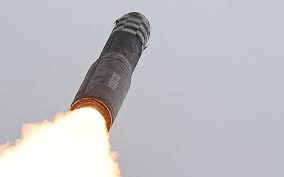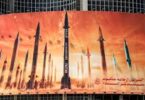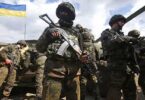David Axe
Yes, the Ukrainian military has had remarkable success with its American-made Patriot surface-to-air missiles – and has even shot down some of Russia’s vaunted Kinzhal hypersonic missiles. No this does not mean the Patriot, or any other air-defense system, is ready to protect the United States and its allies from the most serious missile threats. It’s especially important to appreciate this reality in the aftermath of North Korea’s test-launch of a nuclear-capable intercontinental ballistic missile on Wednesday.
Even after plinking a few Russian hypersonic munitions, Western missile-defense systems are still more effective in theory than they are in reality. If Ukraine’s repeated shoot-downs of incoming Kinzhals are any indication, Russia’s non-nuclear hypersonic missiles aren’t as scary as they may have appeared at first. When the Kinzhal – a 24-foot air-launched missile that travels up to 10 times the speed of sound – first appeared in 2018, Russian president Vladmir Putin declared it impervious to all existing air-defenses on account of its high speed. Putin was wrong or lying. Shortly after deploying their first Patriot batteries in May, the Ukrainians reportedly tweaked the Raytheon-built missile’s software to improve its interception capability – then got to work making the case against the Kinzhal and other Russian super-weapons. On May 13, a Patriot battery shot down five Russian warplanes and helicopters in the span of just a few minutes while the aircraft were flying over southern Russia near the border with Ukraine. The crew of the same battery also claims to have shot down Russian drones, cruise missiles and – yes – Kinzhals. Kill markings are visible on the Patriot’s side in a Ukrainian air force promotional video. “Ukraine’s defense success here may also help to correct perceptions regarding the necessity and value of hypersonic weapons, which have been touted by some as essential at any price,” missile experts Alexander Montgomery and Amy Nelson wrote for the Brookings Institution in Washington DC. It might be tempting to conflate high-speed hypersonic missiles with ICBMs that also fly really, really fast. If a Patriot can shoot down a Mach-10 Kinzhal, surely it or some other air-defense system – the US Army’s Ground-Based Midcourse Defense (GMD) missile or the US Navy’s ship-launched SM-3 – can also defend against a North Korean Hwasong-18 ICBM, and protect American and allied cities from nuclear attack. Right? Wrong, most probably. Unlike Kinzhal style in-atmosphere hypersonic missiles, an ICBM warhead boosts completely out of the atmosphere before reentering it and speeding down toward its target at 20 times the speed of sound.
That’s at least twice as fast as a Kinzhal during the final descent, and the extra-atmospheric part of the journey is much higher. Of all US interceptors, only the GMD can get high enough to stop ICBM warheads in the middle part of their flight up in space, hence its name. It does this by lobbing an “exo-atmospheric kill vehicle” (EKV) up into the warhead’s path. The EKV manoeuvres itself precisely so that the speeding warhead crashes into it, destroying itself as much by its own kinetic energy as the EKV’s. But the GMD has had a spotty test record at best. Even when the US Missile Defense Agency successfully tested one of its 55-foot GMD missiles against what the agency claimed was an ICBM-like target over the Pacific Ocean back in 2017, critics were quick to point out that the target wasn’t actually very realistic.
According to Laura Grego, an analyst with the Union of Concerned Scientists in Massachusetts, the target reached a top speed of just Mach 17. That’s thousands of miles per hour slower than a real ICBM. The unreliability of the GMD has led some US politicians and officials to favour the Navy’s SM-3. This is launched from Aegis warships, and like the GMD it deploys an EKV into the target’s path outside the atmosphere. When the US needed to shoot down one of its own spy satellites which had broken down in 2008, the SM-3 got the job – and it delivered, destroying the satellite as planned. But the SM-3 is limited on the height it can get its EKV up to: it was only intended to beat intermediate-range missiles when it was built, though it has been tested against “ICBM class” targets in recent years. In any case, threats have changed. Rather than regular ICBM warheads soaring ballistically through space, the new menace today is hypersonic “boost glide” warheads such as Russia’s “Avangard”.
These are launched on an ICBM rocket stack, but spend much less time in space and much more time gliding through the atmosphere at high hypersonic speeds, jinking and manoeuvring unpredictably as they come. Space EKVs can’t deal with these, and they are much harder for in-atmosphere interceptors like the Patriot or the naval SM-2 to deal with. That’s not to say that US interceptors are useless. They might offer a defence against a very limited ICBM attack of the sort that North Korea might be able to make against the continental USA or US allies such as Japan. But nobody seriously believes they could stop Russia’s thousands-strong nuclear fleet, or China’s rapidly-growing ICBM force.
Nonetheless, after spending hundreds of billions of dollars over many decades on ever-more-sophisticated missile-defenses, the US military and its allies possess hundreds of air-, sea- and ground-based launchers and many thousands of munitions that can intercept incoming enemy missiles of various capabilities. They can shoot down low- and slow-flying cruise missiles, shorter-range ballistic missiles and, of course, aircraft. They can even hit hypersonic missiles, as the Ukrainians proved. That makes missile defenses a key component of American and allied war plans for, say, a conflict with China over Taiwan. The Chinese People’s Liberation Army Rocket Force has aimed thousands of non-nuclear cruise and ballistic missiles at Taiwan and US and Japanese bases near Taiwan. Beijing’s plan is to bombard Taiwanese defenses in order to soften them up in the early hours of a Chinese attempt to invade Taiwan – and to bombard American and Japanese bases in order to slow an American-led intervention on Taiwan’s side. Patriots and other surface-to-air missile systems could swat away many of the Chinese missiles, blunting that key early bombardment and giving Taiwanese and allied troops a fighting chance to defend the island democracy. Just don’t expect those SAMs to make any difference if a war over Taiwan, or a major war between the two Koreas which drew in China, or a war between Nato and Russia in Europe, escalates to a major strategic nuclear exchange. Both sides would still be destroyed. It’s still as true now as it was in 1949, the year the Soviet Union tested its first fission warhead and joined the United States as a nuclear power: the only way to win an atomic war is to not fight one in the first place.
The Telegraph







